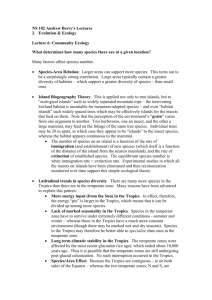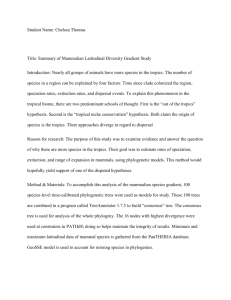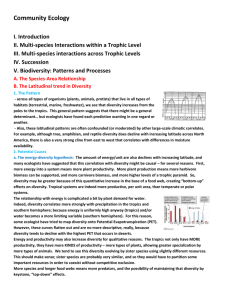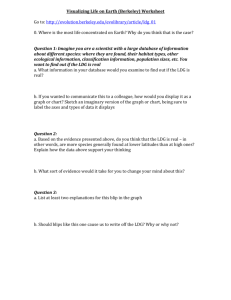Patterns of Biodiversity III
advertisement
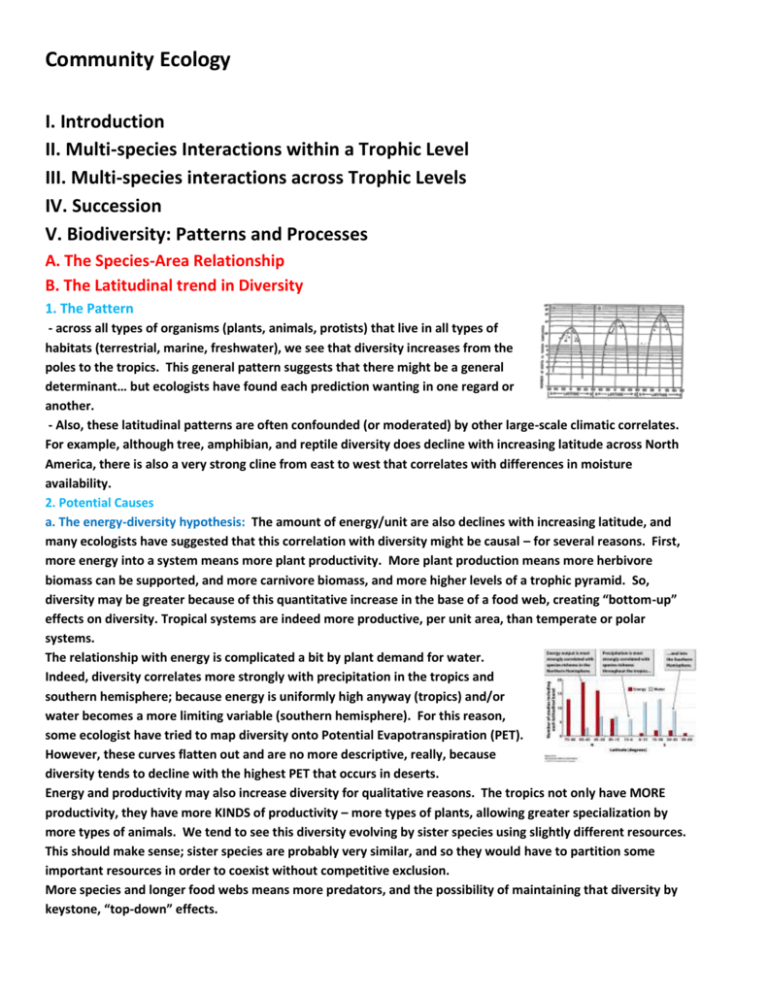
Community Ecology I. Introduction II. Multi-species Interactions within a Trophic Level III. Multi-species interactions across Trophic Levels IV. Succession V. Biodiversity: Patterns and Processes A. The Species-Area Relationship B. The Latitudinal trend in Diversity 1. The Pattern - across all types of organisms (plants, animals, protists) that live in all types of habitats (terrestrial, marine, freshwater), we see that diversity increases from the poles to the tropics. This general pattern suggests that there might be a general determinant… but ecologists have found each prediction wanting in one regard or another. - Also, these latitudinal patterns are often confounded (or moderated) by other large-scale climatic correlates. For example, although tree, amphibian, and reptile diversity does decline with increasing latitude across North America, there is also a very strong cline from east to west that correlates with differences in moisture availability. 2. Potential Causes a. The energy-diversity hypothesis: The amount of energy/unit are also declines with increasing latitude, and many ecologists have suggested that this correlation with diversity might be causal – for several reasons. First, more energy into a system means more plant productivity. More plant production means more herbivore biomass can be supported, and more carnivore biomass, and more higher levels of a trophic pyramid. So, diversity may be greater because of this quantitative increase in the base of a food web, creating “bottom-up” effects on diversity. Tropical systems are indeed more productive, per unit area, than temperate or polar systems. The relationship with energy is complicated a bit by plant demand for water. Indeed, diversity correlates more strongly with precipitation in the tropics and southern hemisphere; because energy is uniformly high anyway (tropics) and/or water becomes a more limiting variable (southern hemisphere). For this reason, some ecologist have tried to map diversity onto Potential Evapotranspiration (PET). However, these curves flatten out and are no more descriptive, really, because diversity tends to decline with the highest PET that occurs in deserts. Energy and productivity may also increase diversity for qualitative reasons. The tropics not only have MORE productivity, they have more KINDS of productivity – more types of plants, allowing greater specialization by more types of animals. We tend to see this diversity evolving by sister species using slightly different resources. This should make sense; sister species are probably very similar, and so they would have to partition some important resources in order to coexist without competitive exclusion. More species and longer food webs means more predators, and the possibility of maintaining that diversity by keystone, “top-down” effects. Finally, another aspect of the energy-diversity hypothesis suggests that the rates of evolution, adaptation, divergence, and speciation might be higher in the tropics under increases energy irradiation. Increased radiations means more mutation (increasing diversity), and higher metabolism, faster development, and shorter generation times. So, in a given amount of time, tropical populations should have greater variation and more bouts of reproduction (read: more opportunities for “differential reproductive success” = SELECTION). So, with more selection, populations should adapt more quickly, diverge from sister populations more rapidly, and speciate more quickly, too – producing more species in the tropics. Curiously, however, Weir and Schluter (2007) found that sister species in the temperate zone have a more recent divergence time than species pairs in the tropics – suggesting that they are of more recent origin. We will revisit this later, though. b. Habitat heterogeneity hypothesis: A landscape with more habitats can hold more species; so perhaps the tropics have more habitats than the temperate zone. This is certainly the case, as they both have tundra, grassland, desert, evergreen, and deciduous forest, while the tropics add rain forest, cloud forest. These differences explain variation and diversity at a landscape scale, however, in terms of beta and gamma diversity. Why, though, might a single forest in the tropics have more diversity than a forest in the temperate zone? The structural diversity in the tropics is greater, too, with emergents and lianas. Animal diversity correlates with structural diversity of the plant community. And of course, the increase in habitat variation could also just be a function of greater habitat area… the tropics have larger expanses of habitat because they are at the fattest part of the earth… so the latitudinal diversity pattern could be a function of the species-area pattern. c. Intermediate Disturbance Hypothesis Connell (1978): The tropics may be more diverse because they experience an intermediate level of disturbance – not as dramatic as a winter, but more localized and patchy and less intense: storms. Disturbance increases with the frequency, intensity, or areal extent of the disturbance. So, winters are strong because they are frequent, intense, and large. A storm is infrequent, local, and patchy in intensity. The idea is this: at low disturbance, competitively dominant species exclude subordinates and diversity is low. At intermediate levels of disturbance, habitat remains open, the superior competitor can’t exclude inferior species, and diversity is high (think Lubchenco). At high disturbance, only the species tolerant of the disturbance can survive and diversity is low. d. Environmental Stability Hypothesis: The temperate zone is interrupted by winter each year, knocking diversity back. Over geologic time, the glaciers covered the temperate zone, driving diversity back. The tropics are warm and stable, and diversity can accumulate – like over successional time. The problem here is that the tropics are seasonal, too – with rainy seasons. Also, the planet was much drier over all during the glacial periods – even the tropical rainforests were reduced to islands with the only large expanses driven by rain shadow effects. However, there is no doubt that these droughts were not as sever as glaciers. And, based on niche measurements, it does appear that some species have had trouble recolonizing the habitats that they may have exploited before the glacier. Study Questions: 1. Describe one taxonomic pattern in species richness where the latitudinal diversity pattern is complicated by patterns in moisture. 2. There are several effects that “energy” might have on diversity. Explain “bottom-up” quantitative and qualitative effects, and also why these would produce top-down effects. 3. Explain the “evolutionary spped” hypothesis. 4. Explain the habitat heterogeneity hypothesis. 5. Describe the intermediate disturbance hypothesis. Why would the tropics have higher diversity under this hypothesis than the temperate zone? 6. Describe how environmental stability might promote tropical diversity.

